Finding the right RV campsite fit is the key to stress-free travel. It’s not just about pretty views—it’s about making sure your rig actually fits the site. In this guide, you’ll learn how to measure your RV, match those numbers to campsite dimensions, and book the perfect spot without surprises.
When I first hit the road in my 31-foot Travel Trailer, I made every rookie mistake—low branches, tight turns, and a pad that barely fit my tires. It was a stressful lesson, but it taught me how critical it is to know your RV’s true size and the details that make or break a good site. Now, I want to help you avoid that same frustration. This will help you find a campsite that fits your RV.
In this step-by-step RV campsite size guide, you’ll learn how to measure your RV’s real dimensions, understand campsite types, and use simple tools to confirm your rig will fit before you click “Reserve.”
Table of Contents
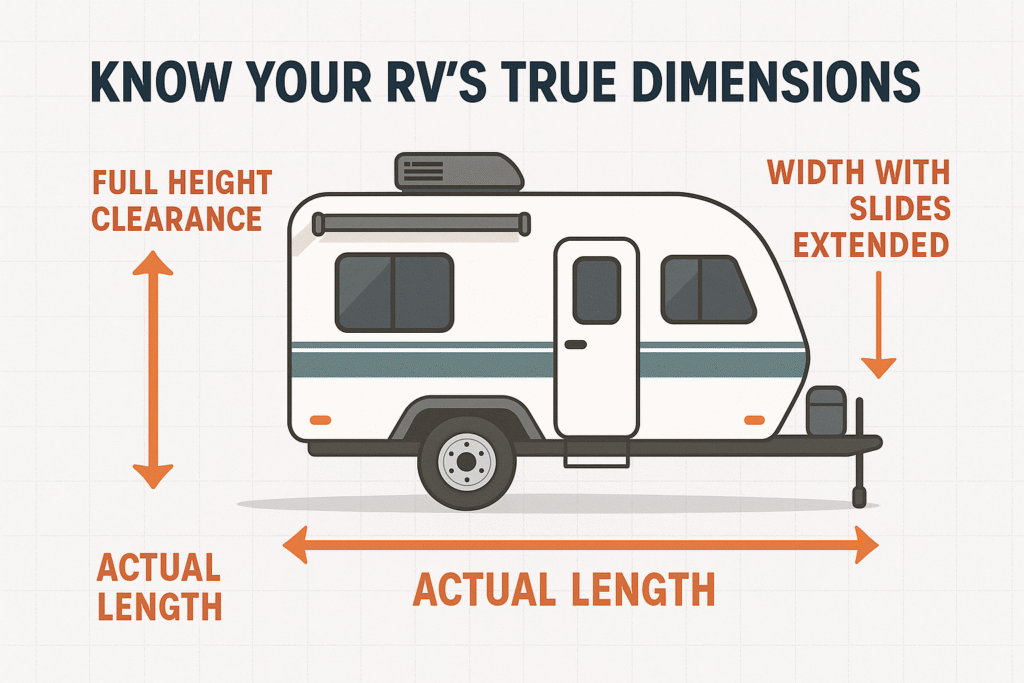
Know Your RV’s True Dimensions Before You Book
Before you can find the perfect campsite, you need to know exactly what you’re working with. Your RV’s true length, width, and height will determine which sites you can safely book—and which ones could cause headaches.
Measure Your RV’s Actual Length and Width
The number printed on your RV’s door or brochure usually refers to floorplan size—not full exterior length. Measure from the very front (including hitch or tow bar) to the very back, adding bike racks or spare tires that can’t be removed. Don’t forget to check your width with slides fully extended—some rigs expand from 8.5 feet to over 14 feet wide.
Know Your Full Height Clearance
Measure from the ground to the highest point—often an air conditioner, satellite dish, or roof vent. Many RVs are taller than you think, often reaching 12 to 13.5 feet. Knowing your real clearance prevents roof damage from bridges, trees, and low power lines.
Factor in Slides, Awnings, and Accessories
Slide-outs, awnings, and accessories can add several feet of width or height once deployed. Always confirm you’ll have room to extend everything fully without hitting trees, posts, or nearby campers.
Knowing these factors will ensure your RV campsite fit is correct.
Pro Tip: Save your exact measurements in your phone’s Notes app or glove box. When booking, add 1–2 feet of buffer space to every dimension—you’ll thank yourself when parking day comes.

Match Your RV Type to the Right Campsite
Not every campsite works for every RV. The best spot for a 45-foot Class A is very different from what a camper van or teardrop trailer needs. Here’s how to find the right match for your specific rig.
Class A and Super C Motorhomes (33–45 feet)
Not every campsite works for every RV. The best spot for a 45-foot Class A is very different from what a camper van or teardrop trailer needs. Here’s how to find the right match for your specific rig.
Class C Motorhomes (24–32 feet)
Class C RVs are the “sweet spot” for most campgrounds. They fit in standard back-in sites and usually need only 30-amp power.
- Great balance between space and accessibility.
- Easily fit into most state and national parks.
- Watch out for low-hanging branches and shorter pad lengths under 30 ft.
Class B Camper Vans (17–23 feet)
These compact rigs open up the most possibilities—they can fit almost anywhere, even tent-friendly sites or smaller national park loops.
- Often only need 20–30 amp power or none at all.
- Can boondock easily with solar or battery setups.
- Use size advantage to camp in scenic, harder-to-access spots.
Travel Trailers & Fifth Wheels
Because you tow them, always factor in your combined length (tow vehicle + trailer).
- Disconnecting the truck saves space on-site.
- Look for level pads with enough space for both trailer and vehicle.
- Fifth wheels often fit better in pull-throughs or wide corner sites.
- Confirm hookup positions—some campgrounds have utilities placed awkwardly for longer rigs.
Pro Tip: When searching online, add your exact RV length to your keyword—like “RV sites 38 feet” or “50 amp pull-through.” Campground directories such as Campendium or The Dyrt often include user-verified length limits.
Pro Tip: If there’s extra space behind the campsite pad, you can pull your RV back until the rear wheels reach the edge of the pad. Let the overhang extend beyond the pad to fit a longer RV into a smaller site.
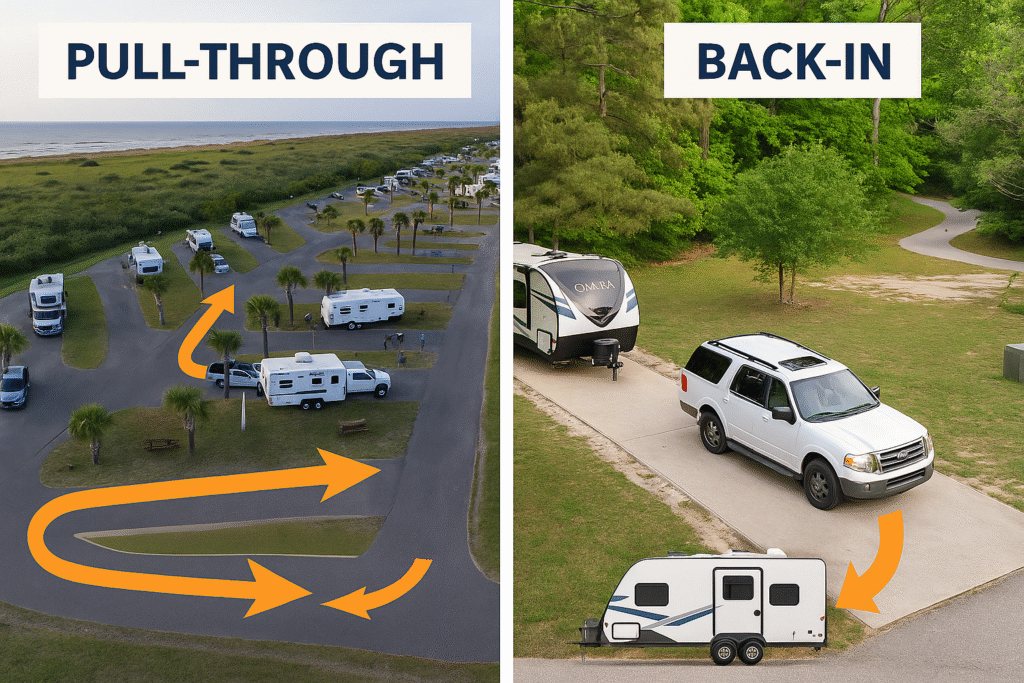
Pull-Through vs. Back-In Campsites
Choosing between a pull-through and a back-in campsite can make setup either stress-free — or stress-filled. The right choice depends on your RV size, driving confidence, and how much privacy you want during your stay. Here is how to find RV campsites that work.
Pull-Through Sites
These are the easiest to access—you simply drive in one side and exit the other.
- Ideal for Class A and large fifth-wheels that need space to maneuver.
- Great for overnight stays when you don’t want to unhook your tow vehicle.
- Usually positioned close to main campground roads for easy access.
- Expect to pay a $10–$20 premium per night at many parks.
- Slight downside: less privacy and more passing traffic.
Pro Tip: Reserve early—pull-throughs are often the first sites booked during peak travel months.
Back-In Sites
Back-in sites take a little more skill but reward you with better privacy and scenic placement.
- Most campgrounds offer more back-in sites than pull-throughs.
- Usually set along outer loops or tucked into trees for shade.
- Perfect for Class C, B, and smaller travel trailers.
- Require backing into position—use a spotter, rear camera, or walkie-talkies for safety.
- Often 10–20 % cheaper than equivalent pull-throughs.

Hookups and Site Services You’ll Need
Once you’ve found a campsite that fits your RV, the next step is to make sure it has the hookups you need. From power to water and sewer connections, knowing what each service does (and what you’ll need to bring) can save you big headaches later.
Full Hookup Sites
A full hookup site gives you everything — electricity, fresh water, and sewer connections right at your pad.
- Perfect for longer stays or full-time RV living.
- You can take longer showers, do dishes, and run your black tank valve open (if the slope allows).
- These sites are usually the most expensive option, but the convenience is worth it.
Our Rating:
4.6 | Our Rating:
4.5 | Our Rating:
4.7 |
$99.99
| $22.99
| |
Description:
| Description:
| Description:
|
- Superior Dual RV Tank Dumping: Streamline dual tank dumping with the RhinoEXTREME 20' RV Sewer Hose Kit. Made with the toughest RV sewer hose, this complete kit ensures easy & efficient dual tank dumping, making your trips effortless & enjoyable.
- APPLICATION: The extension sewer hose is compatible with LITBM and CAMCO 3-inch RV sewer hoses, providing additional length to extend the reach of your RV's sewer hose
- The Ultimate RV Sewer Hose Kit: Camco’s Rhino RV Combo Kit combines the world's toughest RV hose with a complete, no hassle setup for reliable RV sanitation.
Partial Hookup Sites
These provide water and electric, but no direct sewer connection.
- Common in state and national parks.
- You’ll need to monitor tank levels and dump at the station every few days.
- Slightly cheaper than full hookups, and perfect for trips under a week.
Pro Tip: Bring a portable waste tank (“blue boy”) if you plan to stay longer — it saves you from breaking camp just to dump.
Pro Tip: You’ll find that many campgrounds provide dump stations, making it easy to empty your tanks before hitting the road again.
No Hookup or “Dry Camping
Also called boondocking, these sites rely on your RV’s onboard systems.
- Bring filled water tanks, charged batteries, and propane.
- Expect zero hookups — but you’ll often find the most scenic, quiet locations here.
- Stay 3–5 days with good conservation; use solar or generators to extend time.
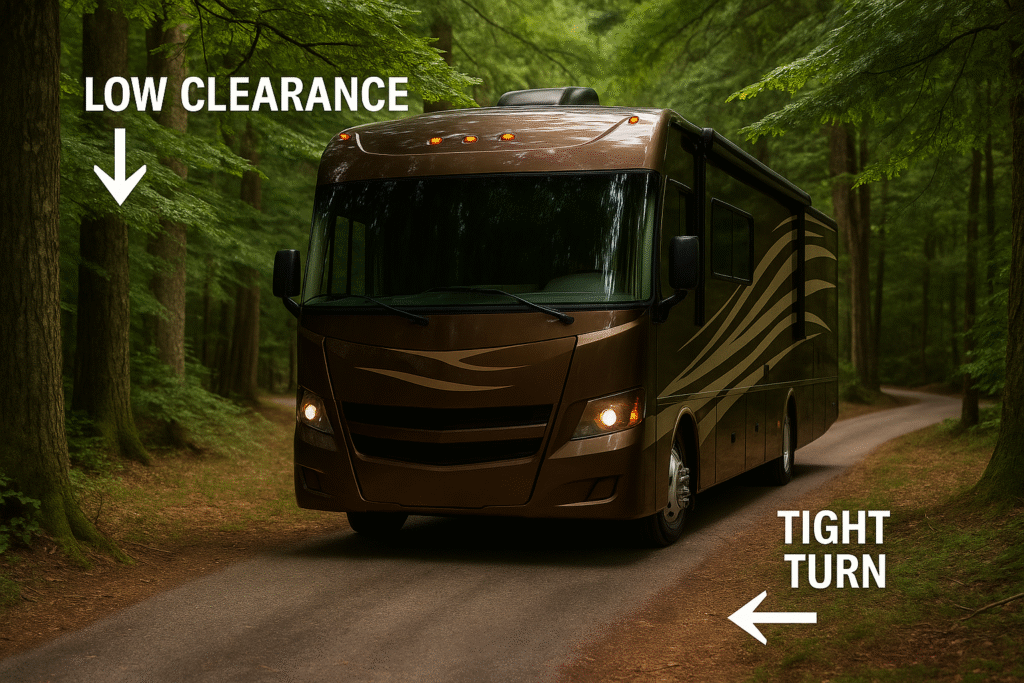
Check the Road and Pad Before You Reserve
Before clicking “Book Now,” take a closer look at how you’ll actually get to your site. Many campgrounds were built decades ago when RVs were smaller, and road width, low branches, or narrow pads can cause real problems for modern rigs.
Road Access and Grades
Not all campground roads are created equal. Watch for steep grades, tight corners, and narrow access roads that make large RVs difficult to navigate.
- Roads with grades over 8–10% can challenge engines and brakes.
- Use satellite view in Google Maps to preview the road layout.
- If a park lists “RV-friendly” or “Big Rig Access,” that’s a good sign.
Pro Tip: Call ahead and ask the campground staff which routes or entrances big rigs use — they often know shortcuts or alternate approaches that GPS doesn’t.
Clearance Hazards
Always verify height clearance on approach roads and within the park. Tree limbs, signs, and low bridges can ruin your day.
- Minimum safe clearance: 13 feet 6 inches.
- If your RV is taller, avoid state parks with older infrastructure.
- Look for “low clearance” reports in apps like RV Life or Campendium.
Pad Length and Surface
Campground websites sometimes list pad length incorrectly or only measure the paved portion. It’s best to know the correct campsite length for RV’s
- Always allow 2–4 feet extra beyond your measured rig length.
- Check the surface type:
- Concrete: Most stable and level.
- Gravel: Good drainage, may need extra leveling blocks.
- Grass/Dirt: Natural look but risky in wet weather.
Pro Tip: Bring SnapPads or rubber stabilizer bases for gravel or dirt pads — they spread the weight evenly and keep jacks from sinking.
Slide-Out Clearance
Even if the pad is long enough, side space can be tight.
- Watch for posts, picnic tables, and trees near the pad edge.
- Ask about slide clearance when booking.
- Some parks allow you to move the fire ring or table — always check first.
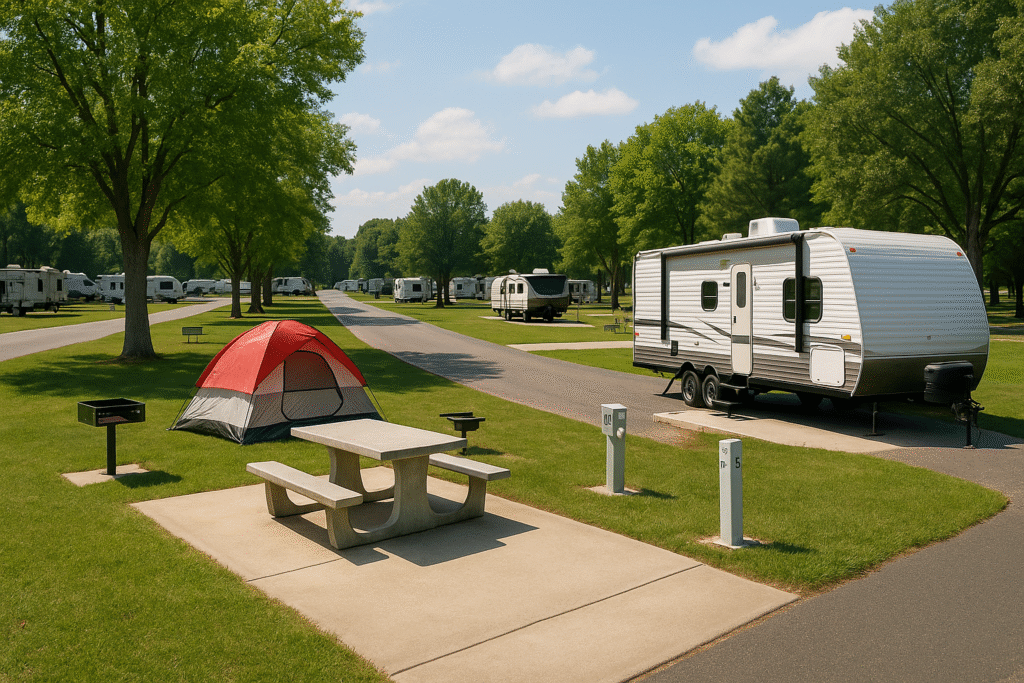
Amenities and Location Factors That Matter
Once your RV fits and the hookups are right, it’s time to think about comfort and convenience. The best campsites balance peace, proximity, and scenery — giving you both a relaxing stay and easy access to what matters most.
Restrooms, Showers, and Laundry
Even if your RV has its own facilities, campground restrooms and showers can make life easier — especially for families.
- Check reviews for cleanliness and water pressure.
- Many premium parks offer private shower rooms and 24-hour laundry.
- If you travel often, look for on-site laundromats with 4+ machines — smaller ones can mean long waits.
Pro Tip: Bring a collapsible laundry basket and detergent pods to keep things tidy inside your RV.
Dump Stations and Water Access
If you’re using a partial hookup or dry camping site, easy dump and refill access is key.
- Look for wide turning lanes and multiple dump stations to avoid long lines.
- Check for non-potable rinse water and freshwater fill stations nearby.
- Use Campendium or Allstays to see photos of dump station layouts before you go.
Campground Stores and Propane
Not all campgrounds stock the same essentials.
- Larger resorts may offer full general stores and propane refills.
- Smaller or remote parks might only sell firewood and ice.
- Always check whether propane refills are available on-site or nearby — it’s easy to overlook until you’re out.
Recreation and Pet Amenities
The best campgrounds keep both people and pets happy.
- Look for dog parks, walking trails, pools, playgrounds, or bike rentals.
- Family resorts often include movie nights or activity centers.
- Adults-only or quiet zones can be great if you want peace and space.
Pro Tip: If traveling with pets, confirm breed restrictions and leash length rules before booking.
Location and Scenery
Campsite surroundings are just as important as amenities.
- Waterfront and mountain-view sites cost more but deliver daily rewards.
- Sites near entrances have easier access but more road noise.
- Edge sites or corner pads offer privacy and extra outdoor space.
- If you work remotely, sites near offices or Wi-Fi towers usually have stronger signal.
Pro Tip: For perfect balance, pick sites halfway between the entrance and perimeter loop — quiet, convenient, and easy to exit on travel day.
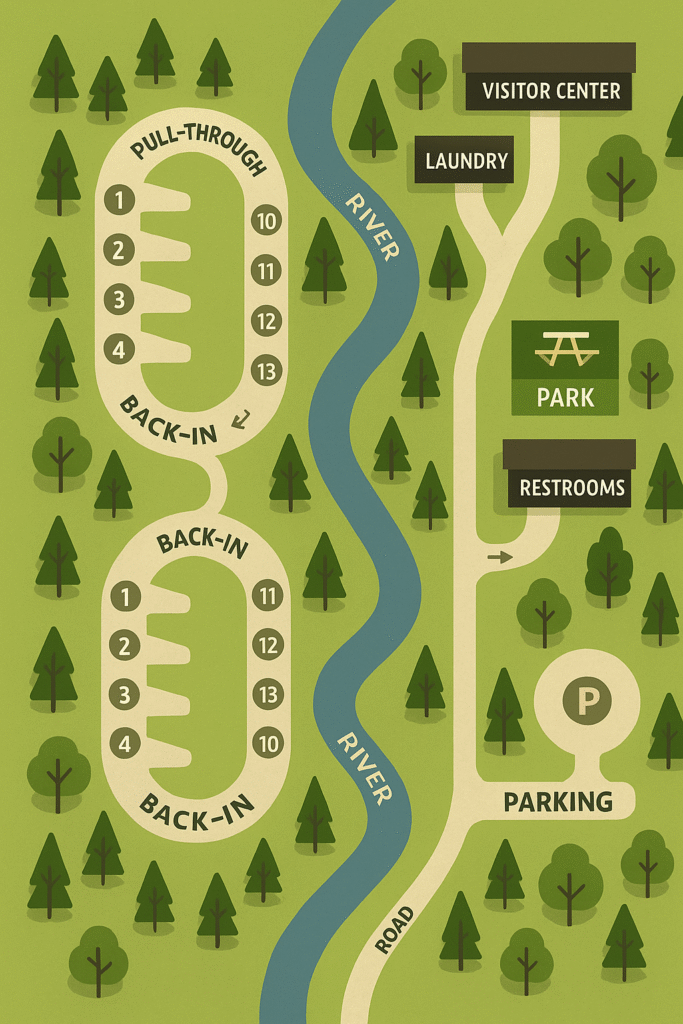
Location and Accessibility Factors
The perfect campsite isn’t just about hookups and space—it’s about where it sits in the campground and how easy it is to reach. Even a beautiful site can become a hassle if it’s hard to access, noisy, or too far from the amenities you use most.
Proximity to Attractions
Choosing a site close to what you want to do saves time and fuel.
- 15–30 minutes from main attractions offers the best balance of access and peace.
- Popular parks near beaches, lakes, or trails often book fast—reserve months ahead.
- If you plan to explore daily, choose campgrounds with easy road access and minimal gate restrictions.
Pro Tip: If you’ll be visiting local attractions multiple days in a row, map your daily route in Google Maps to estimate fuel usage and driving time before booking.
Road Noise and Peace
Campgrounds near main roads can get noisy at night from traffic or early-morning departures.
- ites near entrances and exits are convenient but less quiet.
- Back loops or perimeter sites are quieter but may have longer walks to amenities.
- Ask whether generators are allowed—noise rules vary widely between parks.
Accessibility Inside the Campground
Some campgrounds have older layouts or narrow roads that make maneuvering tricky.
- Look for wide internal roads and gentle corners on maps or in reviews.
- Check for low-hanging branches on interior loops.
- Many RV apps show satellite images where you can see tree cover and turning space.
Pro Tip: Arrive before dusk. Even the best GPS can’t show potholes, ditches, or tree limbs hiding in the shadows.
Cellular Signal and Wi-Fi
Connectivity can vary dramatically, especially in remote campgrounds.
- Read reviews on Campendium—they list real cell test results by carrier.
- Consider bringing a cell booster (like weBoost) if you work remotely.
- For reliable video streaming, sites closer to offices or Wi-Fi towers perform best.
Site Position and View
Where your site sits in relation to the sun, water, or mountains can dramatically affect comfort.
- North-facing sites stay cooler in summer.
- South-facing sites capture more sunlight in winter.
- Edge and corner sites usually offer the best combination of privacy and scenery.
- Waterfront or view sites often add $10–$30 per night, but are worth every penny for long stays.
Pro Tip: Before booking, look up your site number in Google Images or on social media. Many campers post photos that reveal actual shade, spacing, and road layout—better than any campground map.
Reservation Strategies and Tips
Finding the perfect campsite doesn’t help much if it’s already booked! With RV travel at an all-time high, many popular destinations fill up months in advance. Here’s how to time your reservations, what to ask when you call, and a few insider tricks for landing that ideal site. These RV campground booking tips will be helpful.
How Far in Advance to Book
H3: How Far in Advance to Book
The best time to book depends on the season and the popularity of your destination:
- Summer weekends & holidays: Reserve 6–12 months ahead.
- National Parks & coastal campgrounds: Open bookings 6 months out (and can fill in minutes).
- Shoulder seasons (Spring/Fall): Book 1–3 months ahead.
- Off-season & weekday trips: You can often book 1–2 weeks ahead.
Pro Tip: Many park systems open reservations exactly six months to the day — set a reminder and book right when the window opens.
Use Multiple Tools and Alerts
Don’t rely on one site or app. Combine several for better odds:
- Recreation.gov: Best for federal lands and national parks.
- ReserveAmerica: Covers many state parks.
- Campendium, The Dyrt, Hipcamp: Include private and unique sites.
- Arvie, Campnab, Campflare: Send alerts when a site opens from a cancellation.
Pro Tip: Create a shortlist of 3–5 backup campgrounds within 30 minutes of your first choice.
What to Ask When Booking
A quick phone call can save major headaches later. Ask:
- “What’s the pad length and width?”
- “Any trees or posts near the site?”
- “Where are hookups positioned relative to the pad?”
- “Does the site get afternoon shade?”
- “What’s the road width leading to the site?”
Pro Tip: Always confirm the site number and loop name—then check photos of that exact site online if possible.
Last-Minute Openings
Even sold-out campgrounds get cancellations.
- Check daily starting 3–7 days before your desired arrival.
- Many booking sites instantly release cancelled sites back into inventory.
- Be flexible—shifting your stay by one day can often make a spot available.
Understand Cancellation Policies
- Private parks often allow full refunds up to 7 days before arrival.
- State and national parks may charge flat fees ($10–$15) or only refund if you cancel early.
- No-show fees can be one full night’s rate.
Pro Tip: If you’re unsure about travel plans, look for flexible cancellation filters on sites like The Dyrt or KOA.
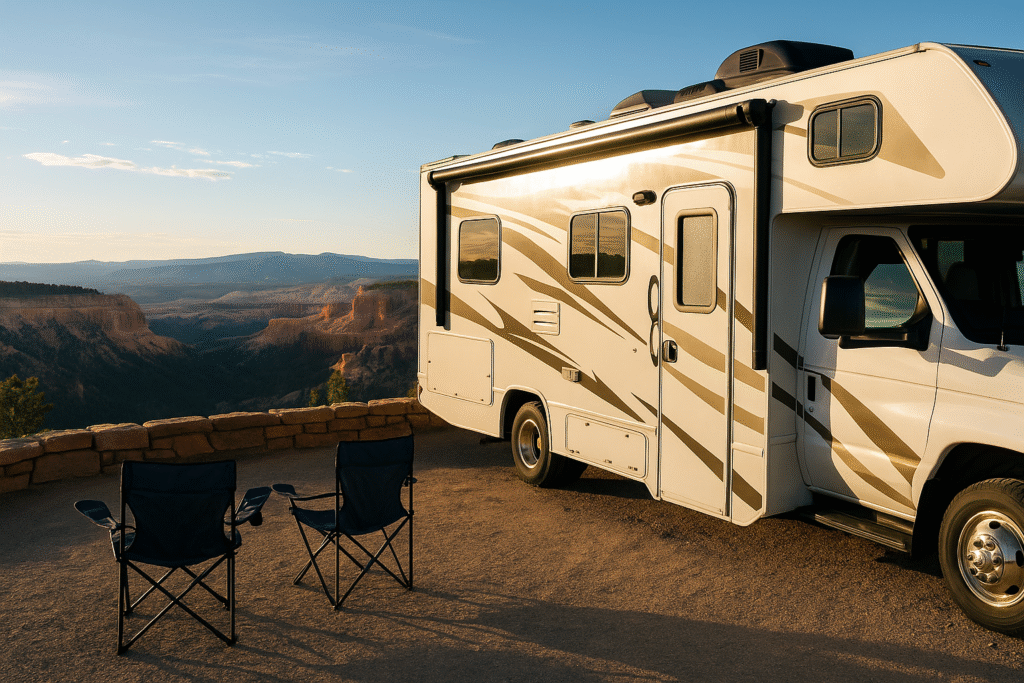
Special Considerations for Different RV Sizes
RV size has the biggest impact on which campsites will work for you. From 45-foot Class A motorhomes to small camper vans, every rig has unique needs. Here’s how to plan smarter based on your size.
Large RVs (Class A and Big Fifth Wheels – 35 to 45 feet)
Big rigs need extra room and infrastructure built for heavy loads.
- Confirm 50-amp power and pull-through access whenever possible.
- Avoid loops built before 2000 — older parks often have tighter turns.
- Arrive during daylight to avoid scraping branches or posts.
- Choose campgrounds that advertise “Big Rig Friendly.”
Pro Tip: Call ahead and ask what the longest RV they’ve hosted is — it’s a quick reality check before booking.
Mid-Size RVs (Class C and Travel Trailers – 25 to 35 feet)
This size hits the “sweet spot” — big enough for comfort, small enough for flexibility.
- You’ll fit into about 80% of state and national park sites.
- Look for back-in sites with open surroundings for easier parking.
- Opt for 30-amp sites in mild weather to save a few dollars.
- Always check for slide-out clearance if trees or posts are nearby.
Pro Tip: A wireless backup camera or walkie-talkies make setup much easier with this size rig.
Small RVs (Class B Vans and Mini Trailers – under 25 feet)
Small rigs are the most versatile — you can camp almost anywhere.
- Fit into tent or mixed-use sites that exclude larger RVs.
- Ideal for national park campgrounds with strict size limits.
- Perfect for boondocking in forests or BLM land.
- Use your compact footprint to find scenic, hard-to-reach spots.
Pro Tip: Search “length limit” before booking national park sites — some restrict vehicles to 27 feet or less.
Whether you drive a luxury Class A or tow a compact camper, the key is knowing your measurements and planning around them. A site that’s perfect for one rig might be impossible for another — preparation is everything.
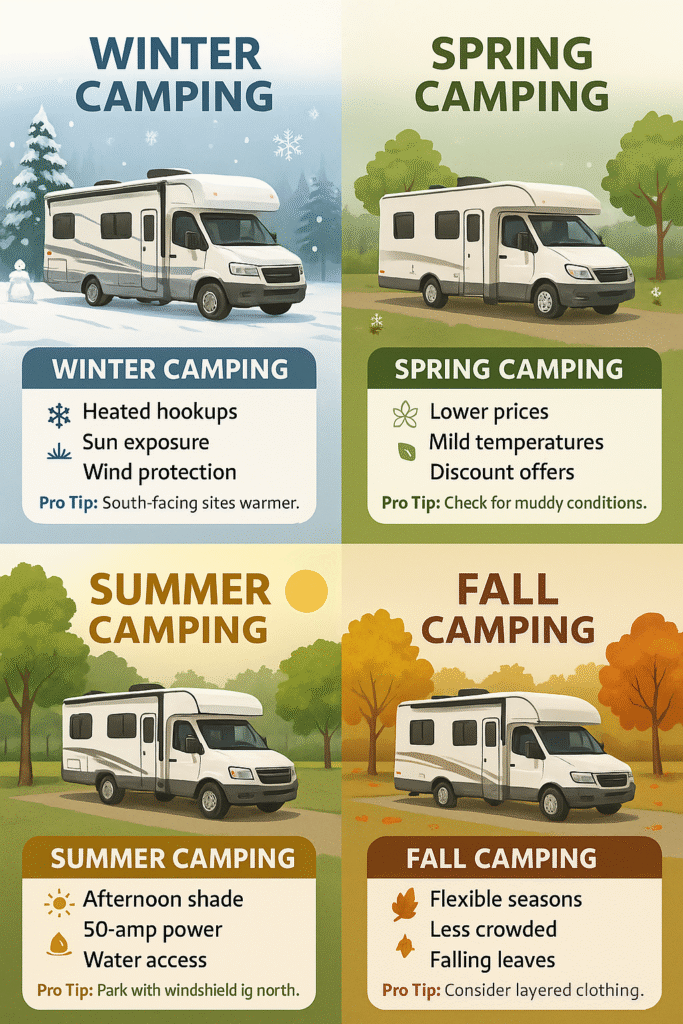
Seasonal Camping Considerations
The time of year you travel can change everything—from how you choose a site to the gear you’ll need to stay comfortable. Whether it’s frozen hookups in January or blazing heat in July, here’s what to know before you book.
Winter Camping
Cold-weather camping can be beautiful but challenging.
- Confirm heated water hookups or bring a heated hose.
- Avoid shaded, icy pads—sun exposure helps thaw water lines.
- Look for wind protection from trees or buildings.
- Check campground maps—some loops close in winter.
- Expect reduced amenities (closed pools, stores, or restrooms).
Pro Tip: Southern-facing sites stay naturally warmer in winter—perfect for morning coffee outside.
Summer Camping
Hot weather brings different priorities.
- Choose sites with mature trees or afternoon shade.
- Look for 50-amp service if you plan to run multiple A/C units.
- Avoid asphalt pads—they absorb and radiate heat.
- Pick campgrounds with water access (lakes, pools, or rivers).
- Always check generator hours—many limit usage during quiet times.
Pro Tip: Face your RV’s windshield north to keep the sun out during the hottest hours.
Spring and Fall (Shoulder Seasons)
The best-kept secret for comfortable camping.
- You’ll find lower prices and fewer crowds.
- Temperatures are mild and ideal for hiking and outdoor cooking.
- Many parks offer discounts of 20–40% in these months.
- Watch for muddy conditions after spring rains or falling leaves in autumn.
Pro Tip: Bring flexible-layered clothing—weather can swing from 40° mornings to 75° afternoons.
No matter the season, planning ahead for weather and temperature can turn a good trip into a great one. Adjusting your setup and site choice for the season helps protect your RV, saves energy, and keeps everyone comfortable.
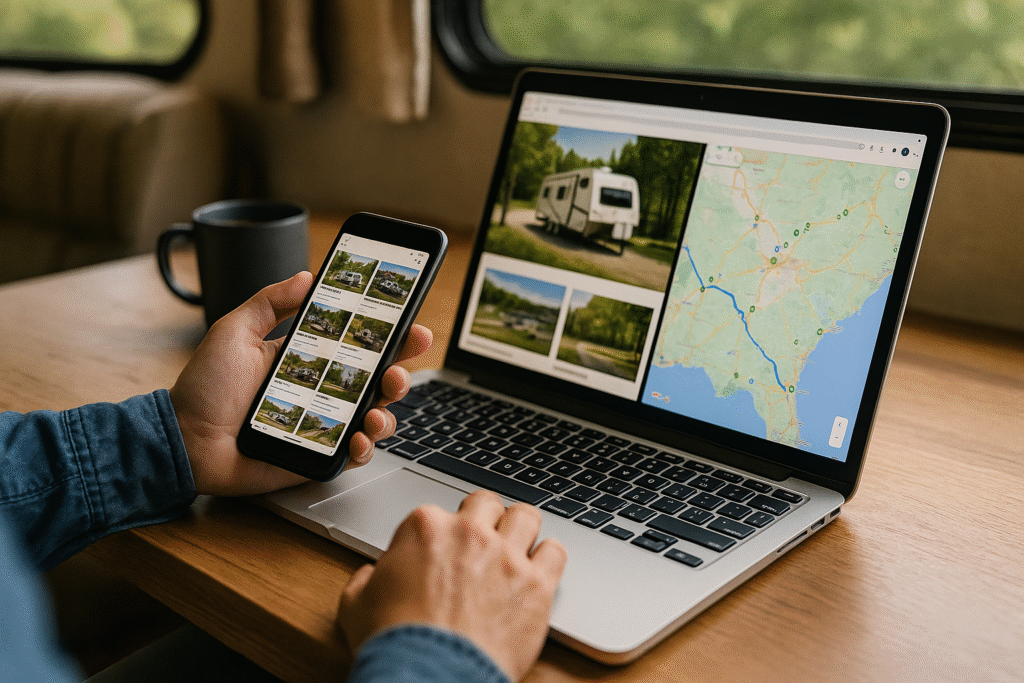
Resources and Tools for Finding the Perfect Campsite
Once you know your RV’s dimensions, the type of site you need, and when to book, the right tools can make campsite hunting easy. These websites and apps help you find verified, RV-friendly spots that fit your rig and travel style.
Best Campground Review and Booking Sites
These apps and directories help you research and reserve sites fast:
- Campendium – Detailed reviews, cell-signal reports, and user photos (great for boondocking).
- The Dyrt – Massive database with filters for hookups, site type, and length.
- RV Life – Combines campsite reviews with RV-safe GPS routing.
- ReserveAmerica – For state parks and public lands across the U.S.
Pro Tip: Save your favorite apps in a dedicated “RV Travel” folder on your phone for quick access on the road.
Navigation and Route Planning
Ensure your route is RV-safe and efficient before you go:
- RV Trip Wizard – Plots routes and campgrounds by your rig size.
- Google Maps (Satellite View) – Check road width and turn radius before arrival.
- Allstays Camp & RV – Find low-clearance alerts, propane fills, and dump stations.
- CoPilot GPS – Offline maps designed for RVs with size-based routing.
Pro Tip: Always compare at least two sources—some apps exclude older or smaller campgrounds by default.
Boondocking and Off-Grid Camping
For travelers who love solitude and scenery:
- FreeRoam – Find public lands and dispersed sites.
- iOverlander – Crowdsourced listings for free and remote camping spots.
- BLM.gov – Official maps for Bureau of Land Management areas.
- Harvest Hosts / Boondockers Welcome – Overnight stays at farms, wineries, and museums (membership required).
Pro Tip: Bring offline copies of maps or GPS coordinates—many boondocking areas have little to no cell service.
Large 7” RV navigator offers a bright, high-resolution touchscreen to easily view your route and map updates of North America.
Find the best roads for your RV with custom routing for the size and weight of your RV.
With so many tools available, planning the perfect RV trip has never been easier. Combining reviews, maps, and GPS data ensures your next campsite fits your rig—and your lifestyle—perfectly.
Conclusion: Finding the Perfect Campsite for Your RV
Choosing the right campsite for your RV is about more than just availability — it’s about matching your rig’s size, your comfort level, and your travel goals. With the right preparation, you can avoid tight turns, low branches, and sleepless nights next to the highway — and instead enjoy peaceful, scenic spots that fit you perfectly.
Ready to put these tips into action? Download our Free RV Campsite Fit Checklist (PDF) to make sure every site you book fits your RV, hookups, and comfort preferences.
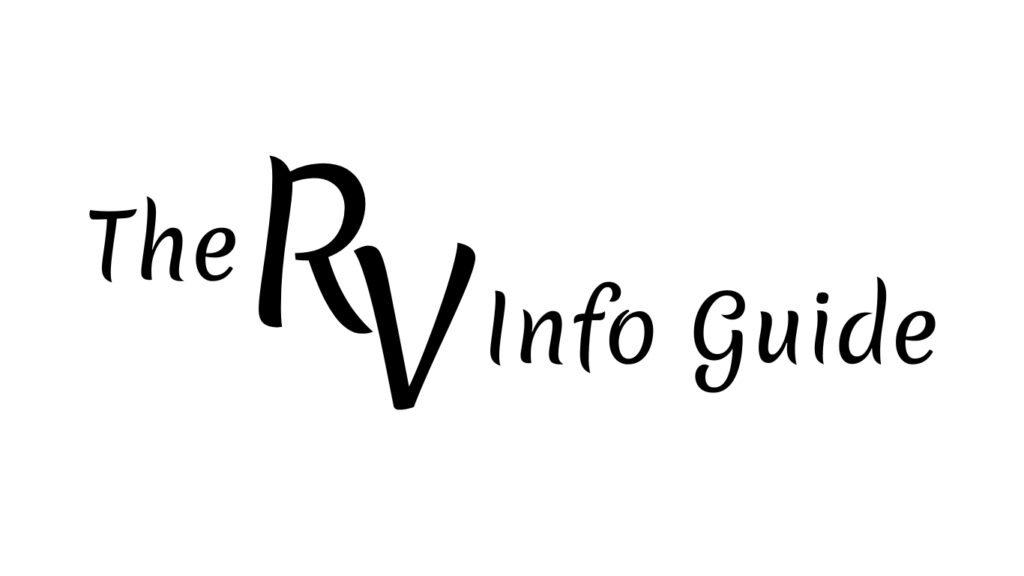
Related Reading





